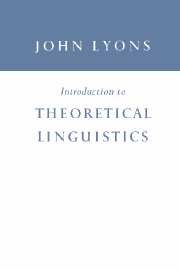Book contents
- Frontmatter
- Contents
- PREFACE TO THE 1995 EDITION
- 1 Linguistics: The Scientific Study of Language
- 2 The Structure of Language
- 3 The Sounds of Language
- 4 Grammar: General Principles
- 5 Grammatical Units
- 6 Grammatical Structure
- 7 Grammatical Categories
- 8 Grammatical Functions
- 9 Semantics: General Principles
- 10 Semantic Structure
- Notes and references
- Addenda
- Bibliography
- Table of symbols and notational conventions
- Index of proper names
- Index of subjects
2 - The Structure of Language
Published online by Cambridge University Press: 05 June 2012
- Frontmatter
- Contents
- PREFACE TO THE 1995 EDITION
- 1 Linguistics: The Scientific Study of Language
- 2 The Structure of Language
- 3 The Sounds of Language
- 4 Grammar: General Principles
- 5 Grammatical Units
- 6 Grammatical Structure
- 7 Grammatical Categories
- 8 Grammatical Functions
- 9 Semantics: General Principles
- 10 Semantic Structure
- Notes and references
- Addenda
- Bibliography
- Table of symbols and notational conventions
- Index of proper names
- Index of subjects
Summary
Introductory
‘Sounds’ and ‘words’
If we were to ask a non-linguist what are the ultimate units of language, the building-blocks, so to speak, out of which utterances are constructed, he might well reply that the ultimate units of language are ‘sounds’ and ‘words’. He might add that words are made up of sequences of sounds, each sound being represented, ideally, by a particular letter of the alphabet (in the case of languages customarily represented by a system of alphabetic writing); and that, whereas the words of a language have a meaning, the sounds do not (their sole function being to form words). These several propositions underlie the traditional view of language reflected in most grammars and dictionaries: the grammar gives rules for the construction of sentences out of words, and the dictionary tells us what the individual words mean. In the following chapters, we shall have occasion to examine critically the terms ‘sound’, ‘word’, ‘meaning’ and ‘sentence’ which figure in these general statements about language. However, for the purpose of the present preliminary discussion of the structure of language, we may leave these terms undefined. Certain distinctions will be indicated in the course of this chapter and will be made explicit later.
Phonology, grammar and semantics
The traditional view of language incorporates the notions of composition (a more complex unit is composed of simpler, or smaller, units: a word is composed of sounds, a phrase of words, a clause of phrases, a sentence of clauses, and so on) and of correlation (each word is correlated with one or more meanings).
Information
- Type
- Chapter
- Information
- Introduction to Theoretical Linguistics , pp. 53 - 98Publisher: Cambridge University PressPrint publication year: 1968
